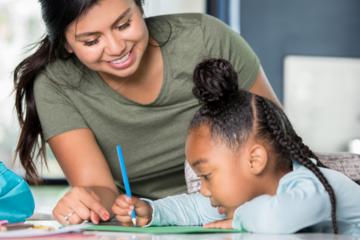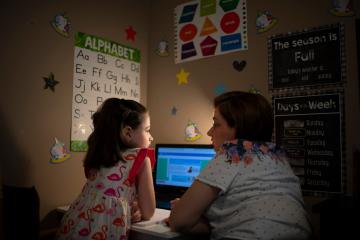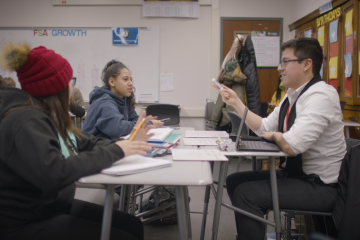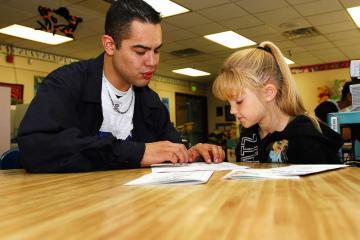Tutoring Pre K-12: Evidence and Resources
In North America, millions of students are behind grade level—a number that will only continue to grow in the wake of Covid-19. This reality is particularly troubling as once students are behind, it can be very difficult to catch up. These issues disproportionately harm low-income students and students of color due to racial and economic inequities embedded within the American education system. As schools work to stabilize and adapt in the wake of Covid-19, effective methods to help students catch up are essential. Tutoring—supplemental one-on-one or small group instruction—represents a proven and agreed-upon strategy to combat Covid-19 learning loss.
The Evidence
J-PAL North America’s Tutoring Evidence Review summarizes the evidence from a meta-analysis of 96 randomized evaluations of tutoring programs. Based on rigorous evidence, the review provides insights on what forms of tutoring are most effective and for whom, and aims to serve as a resource as education leaders, policymakers, and funders work to combat the Covid-19 learning loss, improve student learning outcomes, and minimize the growth of academic disparities.
Key findings from the Evidence Review include:
-
Across all evaluations included in this analysis, tutoring programs consistently lead to significant improvements in learning outcomes for students. The large effect sizes observed across programs identify tutoring as one of the most effective educational tools available.
-
Tutoring programs led by teachers or professional tutors—tutors who are paid and trained—are generally more effective than programs that used nonprofessional (volunteer) or parent tutors. Professional tutors include, among others, school staff members, students in education, and service fellows.
- The effects of tutoring programs tend to be strongest among students in earlier grades, though a smaller set of programs at the secondary level were also found to be effective at improving learning outcomes.
- While overall effects for math and reading tutoring programs are similar, reading tutoring tends to be relatively more effective for students in preschool through first grade, while math tutoring tends to be more effective for students in second through fifth grade.
- Tutoring programs conducted during school tend to have larger impacts than those conducted after school.
Tutoring In Action
One tutoring model that consistently generates significant learning outcomes is Saga Education. Saga Education's tutoring model for high school students who have fallen behind in math rests on five main characteristics: daily sessions with professional tutors, in-school delivery, personalized instruction, supportive relationships with tutors, and a research-based curriculum.
An evaluation of Saga’s program in Chicago Public Schools found that Saga tutoring helped students learn an extra one to two years’ worth of math beyond what their peers learned in an academic year. Tutoring significantly raised participants’ average national percentile rank on math exams, boosted GPA, and reduced math failure rates. A 2021 randomized evaluation found that these gains persisted a year or two after the tutoring occurred, and that the intensive math tutoring led to a rise in both math and non-math grades. For more information about the research behind Saga education see this evidence to policy story.
Policy Recommendations and Resources
The evidence suggests that a major expansion of evidence-based tutoring programs would help improve outcomes for students nationwide. The US Department of Education recommends high-quality tutoring as a strategy to support students post Covid-19, and many states have already begun to implement statewide tutoring initiatives.
As states and districts work to adopt quality tutoring programs on a large scale, J-PAL North America recommends that these programs consider a set of evidence-based guidelines developed by the National Student Support Accelerator at Brown University.
Tutoring sessions should occur at schools either during the school day or immediately before or after the school day.
During-school tutoring has been shown to be more effective than tutoring that happens at a different time or location. Researchers hypothesize that this is due to reduced distractions as well as reduced barriers to access.
Tutoring should occur a minimum of three sessions per week.
For all age groups, this frequency of tutoring has been shown to be significantly more impactful than either one or two days per week. This allows for substantial time to cover academic material and build relationships between tutors and students.
Students should meet with a consistent paid and trained tutor who is supported by ongoing oversight and coaching.
J-PAL North America recommends an increase in support for paraprofessional tutors. Tutors need initial training, consistent oversight, ongoing coaching, and clear lines of accountability. Consistent tutor-student pairings create an opportunity for positive relationships to form. Those interested in exploring tutor training models can visit Saga Education's new Saga Coach tutor training portal.
Tutoring sessions should be informed by data.
Tutors should use data—ideally provided by the school or district—to understand students’ strengths and needs, and should adapt their sessions to focus on where students are behind. Monitoring and consistent data collection will allow tutors to assess their effectiveness at improving student learning and make adjustments accordingly.
Tutoring materials should be aligned with research and state standards.
Materials that tutors use should be aligned with state standards as well as with research on teaching and learning.
For practitioners working to implement tutoring on the ground, we recommend checking out our Implementing Evidence-Based Tutoring for High Impact Learning Path, an accessible and easily digestible series of modules on evidence-based tutoring and evaluation, developed in partnership with CCEE.
We also encourage you to visit the National Student Support Accelerator’s Toolkit for Tutoring Programs. The toolkit seeks to guide practitioners through designing and implementing a new high-impact tutoring program, or improving an existing one.
Featured Media and Resources
Below, find resources and media coverage that expand on the existing evidence on tutoring, including the Biden-Harris Administration's call to expand high-quality tutoring. Additional media includes recommended principles to follow when implementing a tutoring program developed in collaboration with the director of the Institute of Education Sciences at the United States Department of Education, as well as an article in The Hill sharing insights and guidance for effective tutoring co-written by Saga Education.
The Transformative Potential of Tutoring for Pre K-12 Learning Outcomes: Lessons from Randomized Evaluations
Tutoring to accelerate learning
Individualized tutoring to improve learning
Tutoring to Combat COVID-19 Learning Loss
Ongoing Projects
Khoaching with Khan Academy: Leveraging computer assisted learning, teachers, and parents to facilitate personalized learning at scale
Philip Oreopoulos, Joseph Price
Over the last three decades, countries around the world, including the United States and Canada, have experienced a widening gap in school performance between families from high- and low-socioeconomic status (SES) backgrounds (Chmielewski, 2019). The ongoing Covid-19 pandemic has greatly exacerbated this trend. To help reduce learning loss, we propose implementing and testing a computer-assisted learning (CAL) program that helps simulate a personalized tutoring experience at schools serving students who are most at risk of learning loss. Building on our pilot study, the Khoaching with Khan Academy (KWK) program helps assist teachers to use Khan Academy (KA) effectively in their classrooms, offering support and guidance for improving mastery in Grades 4-9 mathematics. We provide coaching (Khoaching) to teachers to introduce regular customizable assignments, monitor and manage progress, and encourage parents and students. The study will examine the program’s impact on math achievement and teacher satisfaction for elementary and secondary school classrooms.
Understanding the importance of summer learning in a pandemic
James Sullivan, Sarah Kroeger, Chloe Gibbs, Sean Corcoran
This study seeks to better understand the role of individualized, virtual summer instruction in redressing learning losses resulting from the Covid-19 school closures. In particular, we are interested in the potential for virtual learning to combat the negative effects of time out of school on achievement gaps. Given the mixed evidence on virtual learning platforms, especially for disadvantaged populations, the prospect of repeated school closures in the upcoming school year points to an urgent need to identify optimal strategies for online education. Our research design is based on a randomized evaluation of a unique summer program in New York City, which will be offered free of charge to public school students in Grades 3-8. All study students will have access to the virtual study materials, and treatment group students will additionally receive synchronous virtual instruction and comprehensive supports. By comparing fall 2020 administrative test scores for the two experimental arms, we will identify the impact of personalized teacher interaction in a virtual setting on student learning. Online assessments from the first week of virtual programming will provide a baseline description of students’ skill levels following a shortened school year.
Partner with J-PAL North America
J-PAL North America welcomes inquiries from education leaders, government agencies, tutoring programs, or other organizations interested in evaluating a tutoring program or implementing evidence-based tutoring at scale. Potential areas of support include interpreting existing evidence, applying evidence across contexts, embedding evaluation into program design, and implementation of evidence-based tutoring models. For more information, please contact Kim Dadisman at [email protected].








